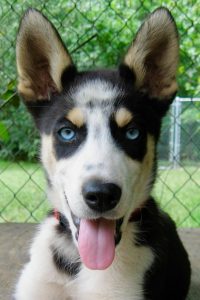It’s Sanka W. Dog here to bring you a book report. My friend, Pam Flowers, has recently written TOGO & Leonhard. So I want to tell you about it because it’s a great read.
TOGO and Leonhard is a true historical account of the role Leonhard Seppala and his lead dog, Togo, played in the 1925 Serum Run. Many of the Balto and Togo stories and movies that are out there are a bit jazzed up – based on the true story but not entirely factual. TOGO and Leonhard is based on almost two years of research and sticks to the facts.
Pam Flowers said it was difficult to find information because the Serum Run happened in 1925 – ninety-five years ago. She used information from thirty-two sources including the Center for Disease Control, stories published in the Nome Nugget and an article that was written by Nome Doctor, Curtis Welsh, and published in the Journal of the American Medical Association in 1925.
The book was a real page-turner. I especially liked it because I knew it was true. Togo was pretty sick when he was born. With lots of tender loving care from Seppala’s wife, Togo grew into a mischievous puppy with a mind of his own. He was small and didn’t have the build of either a freight dog or a racing dog. His future on Leonhard’s team didn’t look bright. It appeared he’d make a better pet than a sled dog. But Togo had other ideas. He was destined to become a great Alaskan hero.
Time was important in getting the diphtheria medicine to the children of Nome. The medicine travelled from Anchorage to Nenana by train. Nenana was still 674 miles from Nome. Now what? Several plans were in the making.
Airplane enthusiasts said flying the medicine would be the fastest. Others said it was too risky to fly in such frigid temperatures. If something went wrong, the medicine would be lost s well as the pilot. That was plan one and it was scrapped.
Plan two involved two dog teams and drivers. One would leave Nenana, and the other would leave Nome. They’d meet half way and exchange the medicine. This was the plan Leonhard knew about.
Plan three was devised after Seppala departed from Nome. To move the serum even faster, a relay of twenty teams was organized. Each team would carry the serum for a distance of between 18 and 53 miles. Every time the serum was passed off it would be warmed.
With remarkable speed the serum traveled over land and reached the coast of the Bering Sea. Likewise from Nome, the Seppala team was moving rapidly toward an undetermined rendezvous point along the coast. The weather would play a factor as a storm was brewing. The wind would determine if it would be safe to cross the frozen surface of Norton Sound. Would it be safer, although longer, to go around Norton Sound by land?
With the serum secured to his sled, Henry Ivanoff left Shaktoolik in a brutal winter storm. Ivanoff decided to cross Norton Sound. He had no idea where Seppala was or what route he would take toward Shaktoolik. Seppala had no idea where the serum was as he headed across Norton Sound toward Shaktoolik. The chance meeting of the two mushers and the exchange of the serum is one of the most thrilling parts of this story.
Togo, and the rest of his team traveled 264 total miles from Nome to the exchange on Norton Sound and back to the Village of Golovin. Unknown to Seppala, more mushers were in place to relay the serum from Golovin back to Nome. After surviving indescribable blizzard conditions between Shaktoolik and Golovin, Seppala was glad to hand the serum off to a fresh team and a warm musher.
What inspired Pam Flowers to write this book? Pam says, “I believe if an author is going to write a book on a subject already written about they need to have something new and unique to say. As a veteran of nine arctic expeditions and an Iditarod finisher I knew I could write a book not only from the perspective of a musher but from an expedition musher.”
Flowers has some pretty impressive credentials to give her that unique perspective. She further explains, “My dogs and I have sledded over many of the same trails as Leonhard Seppala, been trapped for days in powerful blizzards hundreds of miles from home, and learned to depend entirely on ourselves. I know what it’s like to find myself trapped on breaking sea ice with no way to shore. I know what it’s like to fall through the ice and look back on the event and realize I owe my life to a dog. I believe these experiences allowed me to have a unique insight into how Leonhard Seppala felt when these things happened to him and his dogs.”
TOGO and Leonhard is packed full of drama and details about Togo’s journey from being a sickly, rascal puppy to the celebrated lead dog that played a crucial role in saving the children of Nome. It paints a vivid picture of the selfless and skilled dog driver, Leonhard Seppala. Flowers describes the conditions the courageous relay of drivers and dogs traveled through in such detail, you can just about feel the bone chilling cold and brutal winds.
Well there you have it. I’m glad I could tell you about TOGO and Leonhard and the author, Pam Flowers. Pam says, “The book is written as a crossover. It’s written for a 5th to 6th grade reading level but is a good read for adults too.” Hope you will get a copy and read it. Running and pulling a sled is what I like best, but reading is perfect for the Dog Days of Summer when we don’t put a lot of training miles on.
Born to Run,
Sanka




